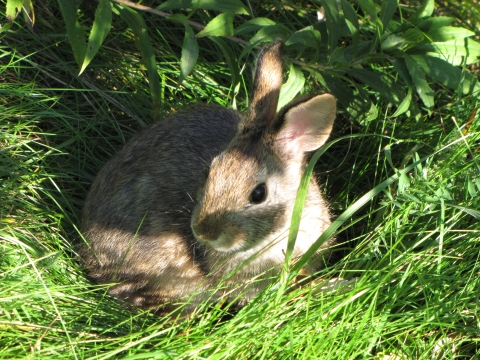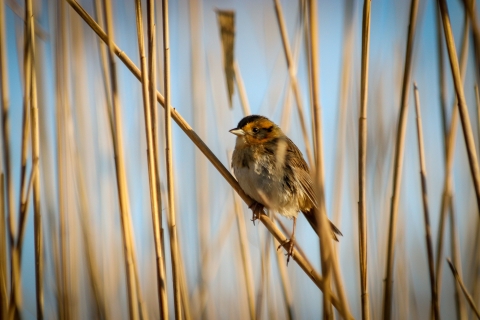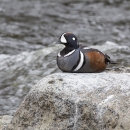Featured Species
New England Cottontail
Numbers of native New England cottontails are decreasing because of habitat loss and competition from the introduced eastern cottontail. the eastern cottontail adapts more easily to residential and disturbed habitats than does the New England cottontail, who prefers very dense shrublands.
Harlequin Duck
This diving duck gets its name from its bright clownlike plumage. Rare along the Atlantic Flyway, impressive numbers of harlequins gather off the rocky shores of Sachuest. In winter, it's always worth a trip here to see them as they feast on periwinkles
Saltmarsh Sparrow
This songbird relies on the high salt marsh salt marsh
Salt marshes are found in tidal areas near the coast, where freshwater mixes with saltwater.
Learn more about salt marsh meadow habitat for cover and nest building. Often, it scurries through the grass like a mouse or vole. When sharp-tailed sparrow nests are damaged by high tides, the most successful sparrows rebuild them. Look for this species in the spring through the summer.
Shrubland
Shrublands consist mainly of shrubs, but this type of habitat also includes native grasses such as little bluestem and flowers like goldenrods, asters and wild radish. Some native shrubs here are the northern bayberry, arrowwood, shadbush and high-bush blueberry. The shrublands of Sachuest are literally buzzing with life, year-round. From the insects pollinating the flowers of tall woody shrubs to rabbits hidden in underground burrows, there is a fantastic diversity of species in this habitat. Even to the trained eye, only a fraction of the shrublands wildlife is visible.
Cobble Beach
These expanses are vital feeding and nesting areas for migrating birds - and are critical breeding habitat for the threatened piping plover. While at the refuge, notice the busy pace of shorebirds as they probe into the sand along the water's edge for juicy worms worms and tasty burrowing mollusks and crustaceans. From wolf spider to beach pea, beaches provide a home for an amazing diversity of wildlife.
Saltmarsh
The salt marsh is a transitional habitat between land and sea, which is mainly defined by salt marsh grasses and other plants firmly rooted in mud and peat. Most large salt marshes have tidal channels meandering through them, where salt and fresh waters mix with the rise and fall of the tides. Another feature of salt marshes are pannes, which are small pools of trapped water that dot the salt marsh meadows.






